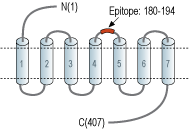Overview
- Peptide CMIEWPEHPNRTYEK, corresponding to amino acid residues 180-194 of rat NK1 receptor (Accession P14600). 2nd extracellular loop.

 Cell surface detection of NK1R by direct flow cytometry in live intact human Jurkat T-cell leukemia cell line:___ Cells.
Cell surface detection of NK1R by direct flow cytometry in live intact human Jurkat T-cell leukemia cell line:___ Cells.
___ Cells + Rabbit IgG Isotype Control-APC (#RIC-001-APC).
___ Cells + Anti-Neurokinin 1 Receptor (NK1R) (extracellular)-APC Antibody (#ATR-001-APC), (2.5µg). Cell surface detection of NK1R by direct flow cytometry in live intact human THP-1 monocytic leukemia cell line:___ Cells.
Cell surface detection of NK1R by direct flow cytometry in live intact human THP-1 monocytic leukemia cell line:___ Cells.
___ Cells + Rabbit IgG Isotype Control-APC (#RIC-001-APC).
___ Cells + Anti-Neurokinin 1 Receptor (NK1R) (extracellular)-APC Antibody (#ATR-001-APC), (2.5µg). Cell surface detection of NK1R by direct flow cytometry in live intact human MDA-MB-231 breast adenocarcinoma cell line:___ Cells.
Cell surface detection of NK1R by direct flow cytometry in live intact human MDA-MB-231 breast adenocarcinoma cell line:___ Cells.
___ Cells + Rabbit IgG Isotype Control-APC (#RIC-001-APC).
___ Cells + Anti-Neurokinin 1 Receptor (NK1R) (extracellular)-APC Antibody (#ATR-001-APC), (2.5µg).
- Pennefather, J.N. et al. (2004) Life Sci. 74, 1445.
- Hershey, A.D. et al. (1991) J. Biol. Chem. 266, 4366.
- Gerard, N.P. et al. (1993) Regul. Pept. 43, 21.
- Caberlotto, L. et al. (2003) Eur. J. Neurosci. 17, 1736.
- Munoz, M. et al. (2011) Expert Opin. Ther. Targets 15, 889.
- Ebner, K. et al. (2009) Curr. Pharm. Des. 15, 1647.
- May, A. and Goadsby, P.J. (2001) Expert Opin. Investig. Drugs 10, 673.
- Palecek, J. et al. (2003) Neuroscience 116, 565.
Substance P (SP), Neurokinin A (NKA) and Neurokinin B (NKB) are all peptides belonging to the Tachykinin protein family. These three peptides, which demonstrate quite a heterogeneity in their distribution, exert their effect via three receptors: Neurokinin 1-3 receptors, members of the G-protein coupled receptor superfamily. However, Neurokinin 1 (NK1) receptor preferentially binds Substance P, Neurokinin 2 (NK2) receptor to NKA, and Neurokinin 3 (NK3) receptor to NKB1.
Neurokinin receptors are distinguished by their seven transmembrane domains, an extracellular N-terminus and a cytosolic C-terminal. An unusual property of these receptors is the presence of introns as part of their structural organization1-3. Tachykinin receptors undergo alternative splicing. For example, NK1 receptor is detected with different C-terminal lengths. The longer receptor isoform is found in the brain whereas the truncated form is mostly detected in the periphery1,4.
Due to the broad expression profile of tachykinin peptides, their respective receptors are also expressed in a similar fashion. NK1 receptor is widely expressed in neurons, endothelial cells, muscle and immune system cells. NK2 receptor is broadly expressed in the periphery and its expression in the brain is quite restricted. NK3 receptor on the other hand is largely expressed in the central nervous system and is also detected in the uterus, skeletal muscle, lung and liver1.
Neurokinin receptors have been found in many pathophysiological indications and have therefore become targets for the development of pharmacological compounds. Such indications include cancer, psychological disorders, migraine and various inflammations, just to name a few5-8.
Application key:
Species reactivity key:
Anti-Neurokinin 1 Receptor (NK1R) (extracellular) Antibody (#ATR-001) is a highly specific antibody directed against an epitope of the rat protein. The antibody can be used in western blot, indirect live cell flow cytometry, and live cell imaging applications. It has been designed to recognize NK1 receptor from rat, mouse, and human samples.
Anti-Neurokinin 1 Receptor (NK1R) (extracellular)-APC Antibody (#ATR-001-APC) is directly conjugated to Allophycocyanin (APC) fluorophore. This conjugated antibody has been developed to be used in immunofluorescent applications such as direct flow cytometry and live cell imaging.
